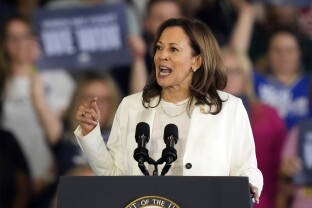Vice President Kamala Harris’ focus on the affordable housing crisis has excited experts in the field. However, their praise comes with a “but”: Her plan relies on a lot of movement in areas presidents don’t have much control over, and if the policy is only implemented halfway, it could backfire.
Harris has called for measures to build millions of homes, and a program to give Americans the money to buy them. That includes tax incentives for builders, investors — particularly those focused on low-income housing — and a proposed $25,000 in down payment assistance for first-time buyers.
“We know that the core gist of the problem that we are having in the housing market right now is lack of supply, especially at the affordable end of the housing market, which is the type of housing that the first-time homebuyers would like to access. So I think that’s probably the main reason that this has the supply solution at the top,” Jung Choi, a researcher with the liberal-leaning Urban Institute, said of the Harris campaign’s plan. “But then the thing is that it does take time to build.”
Building homes takes a lot of work, from navigating local-level red tape to convincing builders that the incentives are worth their while. Factors like zoning are decided at the state and local level.
“That’s a very laudable goal. I think that’s something they could try to chase down, but it’s really hard,” said Mark Eppli, a real estate economist at the University of Wisconsin-Madison.
In all, these experts said that Harris’ vision, if implemented in totality, could work. But if enough houses aren’t built, some say it carries the risk of increasing prices. “We’re gonna have more buyers with the same supply. It’s not really gonna address the problem,” Eppli said of a scenario in which financial assistance outpaces the number of new homes built.
Already, the S&P U.S. National Home Price Index is up 48% since 2020 and a staggering 79% since 2016. There’s an estimated shortage of between 4 to 7 million homes in the country. And it’s tough to compete against investors, who are snapping up what they can: low-priced homes made up almost half of all investor purchases in the fourth quarter last year.
“If we just push for the demand-side policy in the faster place compared to the supply-side, I think there is a risk of just increasing the price,” Choi said. “In order to have the [intended] effect of this demand-side policy, it really has to align with the timing of the supply-side.”
Harris set a goal of building 3 million new housing units (both for rent and purchase), by creating a tax incentive for builders who construct starter homes sold to first-time homebuyers, expanding the Low Income Housing tax credit, doubling a proposed Biden-Harris homebuilding innovation fund and trying to cut red tape that inhibits homebuilding. The down payment support is an expansion of a Biden-Harris proposal to offer similar aid to 400,000 first-generation homebuyers, and seeks to reach over 4 million Americans over four years.
Not all housing experts are as worried about the risks of giving cash assistance to first-time buyers.
“I’m seeing a criticism of ‘Well, this will just show up in house prices,’ which I think is a legitimate thing to think about,” Richard K. Green, director and chair of the University of Southern California’s Lusk Center for Real Estate said. “But my only evidence is what happened when the mortgage deduction was cut back substantially [in 2017] and I did not see a big price effect in the market. And I suspect what’s going on is these things are still very small relative to all the other stuff that happens in the market.”
Similar policies to financially help first-time homebuyers have been put into effect at a local level. Detroit has used $12 million from the American Rescue Plan to help over 400 lower-to-middle income locals enter home ownership, by providing up to $25,000 in down payment assistance. The city announced an additional $7 million towards the program in June. According to Forbes, there are over 2,500 programs provided by states, localities, charities and private lenders to help meet down payment requirements.
The bigger question mark is over matters a Harris administration cannot control.
“There’s a lot of stuff gumming this up that is very difficult. Even if you were to magically transform zoning tomorrow, which I absolutely think we should do, it will take a long time for that to actually show up in a meaningful way, and I don’t know how to get around that,” Green said.
The Harris-Walz campaign includes the need to “Cut Red Tape and Needless Bureaucracy.” But what does that mean for a president who can’t change local laws?
“As far as what are the federal policy levers to change these zoning rules, the consensus is there really aren’t many. Because these barriers exist at the state and local level, there’s not much a president or even a Congress can do to change those state and local laws,” said Paul E. Williams, founder and executive director of the Center for Public Enterprise. “That’s why I think this kind of bully pulpit and messaging tying these things together is actually one of the most proactive things that someone can do to address those challenges,” he said.
Eppli and Choi also suggested implementing some sort of “stick” to pair with the “carrot” incentives in the policy proposals: conditioning other forms of federal-to-state support to localities speeding up clearing the “red tape.”
Increasing the supply of affordable housing could be a “bipartisan sweet spot,” tough to find in a deeply divided Congress. The Harris-Walz proposed tax incentive for homebuilders who sell starter homes, for example, would complement the pending Neighborhood Homes Investment Act, which has broad bipartisan support across both arms of Congress. And politically, it would behoove Harris to see housing supply go up while she’s in the White House, as opposed to years later.
That said, the guiding policy document in the conservative movement indicates just how widespread the challenges for Harris’ housing proposal are. Project 2025, a product of the conservative Heritage Foundation that’s being heavily targeted by Democrats this fall, states “Congress should prioritize any and all legislative support for the single-family home.”
And shortly after: “Localities rather than the federal government must have the final say in zoning laws and regulations, and a conservative Administration should oppose any efforts to weaken single-family zoning.”
—
Nuha Dolby is a NOTUS reporter and an Allbritton Journalism Institute fellow.
Sign in
Log into your free account with your email. Don’t have one?
Check your email for a one-time code.
We sent a 4-digit code to . Enter the pin to confirm your account.
New code will be available in 1:00
Let’s try this again.
We encountered an error with the passcode sent to . Please reenter your email.


